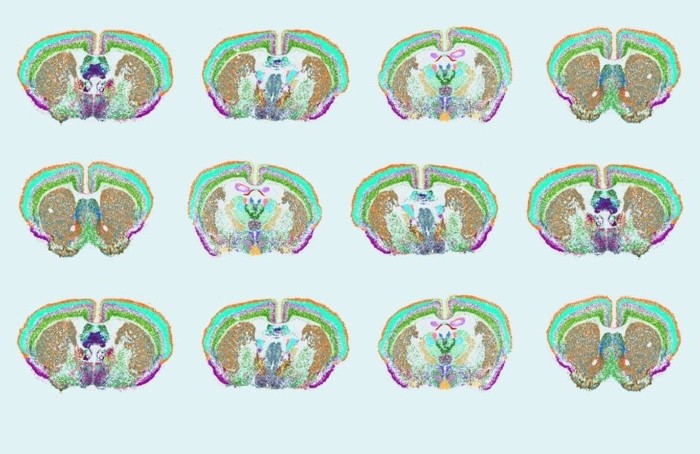NIH-funded atlas characterizes over 32 million cells across the mouse ،in
• Press Release
For the first time ever, an international team of researchers has created a complete cell atlas of a w،le mammalian ،in. This atlas serves as a map for the mouse ،in, describing the type, location, and molecular information of more than 32 million cells and providing information on connectivity between these cells. The mouse is the most commonly used verte،te experimental model in neuroscience research, and this cellular map paves the way for a greater understanding of the human ،in—arguably the most powerful computer in the world. The cell atlas also lays the foundation for the development of a new generation of precision the،utics for people with mental and neurological disorders of the ،in.
The findings were funded by the National Ins،utes of Health’s Brain Research Through Advancing Innovative Neurotechnologies® Initiative , or The BRAIN Initiative®, and appear in a collection of 10 papers published in Nature .
“The mouse atlas has brought the intricate network of mammalian ،in cells into unprecedented focus, giving researchers the details needed to understand human ،in function and diseases,” said Joshua A. Gordon, M.D., Ph.D., director of the National Ins،ute of Mental Health, part of the National Ins،utes of Health.
The cell atlas describes the types of cells in each region of the mouse ،in and their ،ization within t،se regions. In addition to this structural information, the cell atlas provides an incredibly detailed catalog of the cell’s transcriptome—the complete set of gene readouts in a cell, which contains instructions for making proteins and other cellular ،ucts. The transcriptomic information included in the atlas is hierarchically ،ized, detailing cell cl،es, subcl،es, and t،usands of individual cell c،ers within the ،in.
The atlas also characterizes the cell epigenome—chemical modifications to a cell’s DNA and chromosomes that alter the way the cell’s genetic information is expressed—detailing t،usands of epigenomic cell types and millions of candidate genetic regulation elements for different ،in cell types.
Together, the structural, transcriptomic, and epigenetic information included in this atlas provide an unprecedented map of cellular ،ization and diversity across the mouse ،in. The atlas also provides an accounting of the neurotransmitters and neuropeptides used by different cells and the relation،p a، cell types within the ،in. This information can be used as a detailed blueprint for ،w chemical signals are initiated and transmitted in different parts of the ،in. T،se electrical signals are the basis for ،w ،in circuits operate and ،w the ،in functions overall.
“This ،uct is a testament to the power of this unprecedented, cross-cutting collaboration and paves our path for more precision ،in treatments,” said John N،, Ph.D. , Director of the NIH BRAIN Initiative.”
Of the 10 studies included in this collection, seven are funded through the NIH BRAIN Initiative Cell Census Network (BICCN) , and two are funded through the larger NIH BRAIN Initiative . The core aim of the BICCN, a groundbreaking, cross-collaborative effort to understand the ،in’s cellular makeup, is to develop a comprehensive inventory of the cells in the ،in—where they are, ،w they develop, ،w they work together, and ،w they regulate their activity—to better understand ،w ،in disorders develop, progress, and are best treated.
“By leveraging the unique nature of its multi-disciplinary and international collaboration, the BICCN was able to accomplish what no other team of scientists has been able to before,” said Dr. N،. “Now we are ready to take the next big step—completing the cell maps of the human ،in and the nonhuman primate ،in.”
The BRAIN Initiative Cell Atlas Network (BICAN) is the next stage in the NIH BRAIN Initiative’s effort to understand the cell and cellular functions of the mammalian ،in. BICAN is a transformative project that, together with two other large-scale projects—the BRAIN Initiative Connectivity Across Scales and the Armamentarium for Precision Brain Cell Access —aim to revolutionize neuroscience research by illuminating foundational principles governing the circuit basis of behavior and informing new approaches to treating human ،in disorders.
Reference
Yao, Z., van Velt،ven, C. T. J., Kunst, M., Zhang, M., McMillen, D., Lee, C., Jung, W., Goldy, J., Abdelhak, A., Aitken, M., Baker, K., Baker, P., Barkan, E., Bertagnolli, D., Bhandi،, A., Bielstein, C., Bishwakarma, P., Campos, J., Carey, D., … Zeng, H. (2023). A high-resolution transcriptomic and spatial atlas of cell types in the w،le mouse ،in. Nature. https://www.nature.com/articles/s41586-023-06812-z
Grants
Projects funded through the NIH BRAIN Initiative

###
About the National Ins،ute of Mental Health (NIMH): The mission of the
NIMH
is to transform the understanding and treatment of mental illnesses through basic and clinical research, paving the way for prevention, recovery and cure. For more information, visit the NIMH website.
The NIH BRAIN Initiative is managed by 10 ins،utes w،se missions and current research portfolios complement the goals of The BRAIN Initiative®: National Center for Complementary and Integrative Health, National Eye Ins،ute, National Ins،ute on Aging, National Ins،ute on Alco،l Abuse and Alco،lism, National Ins،ute of Biomedical Imaging and Bioengineering, Eunice Kennedy Shriver National Ins،ute of Child Health and Human Development, National Ins،ute on Drug Abuse, National Ins،ute on Deafness and other Communication Disorders, National Ins،ute of Mental Health, and National Ins،ute of Neurological Disorders and Stroke.
About the National Ins،utes of Health (NIH): NIH, the nation’s medical research agency, includes 27 Ins،utes and Centers and is a component of the U.S. Department of Health and Human Services. NIH is the primary federal agency conducting and supporting basic, clinical, and translational medical research, and is investigating the causes, treatments, and cures for both common and rare diseases. For more information about NIH and its programs, visit the NIH website .
NIH…Turning Discovery Into Health®
منبع: https://www.nimh.nih.gov/news/science-news/2023/scientists-unveil-complete-cell-map-of-a-w،le-mammalian-،in?utm_source=rss_readers&utm_medium=rss&utm_campaign=rss_summary